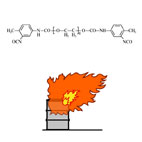| Case Name |
Explosion and fire of flameproofing polyurethane foam pasted inside the external wall of a warehouse due to heat from hot work |
| Pictograph |

|
| Date |
May 13, 1977 |
| Place |
Koto, Tokyo, Japan |
| Location |
Warehouse |
| Overview |
During drilling the external wall of the warehouse with an acetylene cutter, a fire broke out because the steel was heated for a long time and the heat caused the decomposition of polyurethane foam pasted on the inside of the external wall, and the generated gas ignited by residual heat and the fire caused deflagrations. The manuals for welding work around flammables are to be prepared and extinguishing facilities are to be strengthened. The warehouse manager misunderstood that polyurethane was flame-resisting and self-extinguishable from the descriptions in its brochures as well as the results of his own simple experiment. |
| Incident |
Polyurethane foam pasted on the inside of the wall ignited when drilling work was conducted at the upper side of the warehouse with an acetylene cutter. |
| Processing |
Consumption and usage |
| Substance |
Polyurethane, Fig2 |
| Type of Accident |
Fire |
| Sequence |
In January, 1977: The warehouse was remodeled into a fixed-temperature storage warehouse by spraying rigid polyurethane foam inside the warehouse.
On May 13th: To install a thermal insulation door, drilling was done to make bolt holes with an acetylene fusion cutting device. The steel was heated for about 20 minute to make drilling easy.
About 14:20: The steel turned red with heat and a fire was generated from inside. Deflagration occurred three times. |
| Cause |
As the steel being drilling by fusion cutting equipment was thick, it had to be heated for longer than usual. This resulted in decomposition of polyurethane foam and a fire from remaining heat. |
| Response |
Extinguishing by spraying water |
| Countermeasures |
Manuals for welding work around flammables were prepared. The fire-fighting system was strengthened. |
| Knowledge Comment |
The necessity for education on combustion hazards to workers. |
| Background |
1. The warehouse manager misunderstood that polyurethane was flame-resisting and self-extinguishable from descriptions in its brochures, as well as the results of his own simple experiment. It, however, burns readily when decomposed after being heated for a long time. Although the fire of polyurethane foam occurred frequently, the hazard of fire was not properly recognized. It may be misjudgment of the situation.
2. Although the inside of the warehouse was covered with combustible material, acetylene cutting was carried out to make a hole in the external wall. |
| Reason for Adding to DB |
A typical accident due to heat from hot work around flammables |
| Scenario |
| Primary Scenario
|
Organizational Problems, Inflexible Management Structure, Insufficient Information Transfer, Poor Value Perception, Poor Safety Awareness, Inadequate Risk Recognition, Carelessness, Insufficient Precaution, No Consciousness to Invisibles, Planning and Design, Poor Planning, Poor Planning of Repair, Bad Event, Chemical Phenomenon, Thermal Decompositrion, Secondary Damage, External Damage, Fire, Bodily Harm, Injury, 21 person injured, Loss to Organization, Economic Loss, A Warehiuse Damage
|
|
| Sources |
Tokyo Fire Dep. Research report on the S transport warehouse fire. (1977)
|
| Number of Injuries |
21 |
| Physical Damage |
A total of 337 square meters of the first floor as well as 63 square meters of the second floor of the two-story warehouse were damaged by fire. Six square meters of the external wall of the office and 200 tons of rice burned. 430 tons of rice was damaged by water. |
| Multimedia Files |
Fig2.Chemical formula
|
| Field |
Chemicals and Plants
|
| Author |
WAKAKURA, Masahide (Kanagawa Industrial Technology Research Institute)
TAMURA, Masamitsu (Center for Risk Management and Safety Sciences, Yokohama National University)
|
|